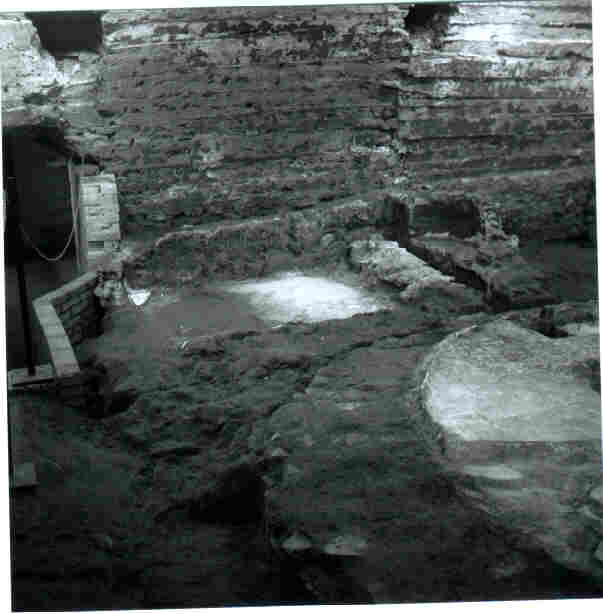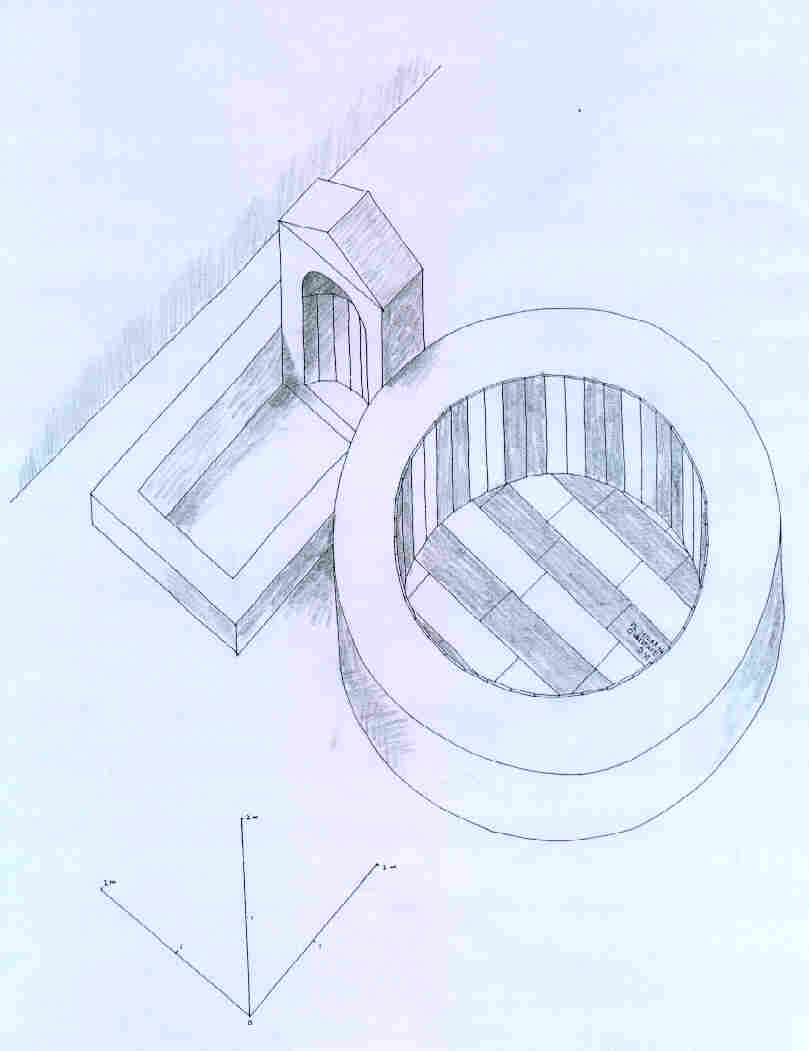Swedish Research in
San Lorenzo in Lucina
(Rome)
- The Transformationsof a Late Antique
Roman Quarter
ROMAN AND
EARLY CHRISTIAN
PHASES
Made by: Olof Brandt
Swedish Institute in Rome
Web page:
http://www.svenska-institutet-rom.org
Via Omero 14
I-00197 Rome, Italy
E-mail: isvroma@vatlib.it
| AN EARLY CHRISTIAN BAPTISTERY | The baptistery |
| Early Christian baptisteries | Early christian texts about baptism |
| The washing of feet after baptism | Ambrose writes about feet washing |
The Baptistery
The excavations 1982-1987
had uncovered most ancient remains beneath the church and beneath the side
chapels (like the North-South corridor to the right on the clickable plan,
beneath the right hand side chapels of the church: North is up!).

However, at the final stage of the excavations, an interesting circular structure emerged in the crypt beneath an old chapel outside the church (the square room at the top left of the plan). This structure was identified as a baptistery and was completely uncovered by the Swedish Institute in 1993. The baptistery is found outside the basilica. The font surely was built in a room, a chapel, outside the right nave of the basilica, but we have no traces of its outer walls. They were pulled down completely in the 15th century when the still standing chapel (now ex Sala dei Canonici, Museo parrocchiale) was built. What we have is the circular font and a rectangular secondary basin. They are both in very bad conditions.
The baptismal font itself consisted of a circular basin with an internal diameter of about 3 and a half meter. A circular brick wall, 65 cms thick and clad with marble, was the rim of the font. But this wall was also damaged in the fifteenth century. How high was it? Perhaps about one meter? Its inside was clad with white marble and bluish cipollino marble. One of these cipollino marbles is a reused funerary inscription of a woman called Hilarina, who died in the fourth century. This circular font must be were solemn baptism was celebrated on Easter and Pentecost.
We have no clues as to the function of the secondary basin, except that it clearly contained water. Was it used for the washing of
feet? Some sources mention this rite after immersion and anointing. St.
Ambrose in Milan wrote in 380-390 that this part of the rite had been left
out in Rome . For this reason, the secondary basin in San Lorenzo in Lucina
could be used for the washing of feet only if the baptistery was built
some time before Ambrose wrote, in the mid fourth century.
Another possibility is that the secondary basin was used for the blessing of the water before the baptism. Some martyr legends, the so called "Passiones", written i Rome in the fifth century, describe how baptism was celebrated in Rome in that period. And they often mention that as there seldom was any running water, the water was first brought - allata est aqua - and then blessed. The water would then have been taken from this basin after the blessing and used for the baptism in the bigger font. Later history of the baptistery This fifth century baptistery was used in a thousand years. It was rebuilt several times. The circular font had one or two steps added on its west side, perhaps in the general reconstruction of the chucrh in the eight century, or already earlier. Probably this step was meant for the priest who baptized and who didn't want to get his feet wet. Such steps can be found also in the churches San Crisogono and Santo Stefano in Via Latina in Rome. The big reconstruction of the entire church took place after its destruction by the Normands in 1084. Probably this is when the bottom of the circular font was covered with a kind of plaster called cocciopesto, and the secondary basin was completely covered. The hole in the middle probably shows that from now on, baptism was celebrated in a smaller font of the modern kind as we are used to today. All the remains of the old baptistery were covered up by the floor of a new chapel built in the fifteenth century. An important tomb destroyed part of the circular font which no longer was visible. M E Bertoldi understood that this was the chapel of St. John the Baptist, mentioned in the old documents, which means that the chapel still was used for baptism for some centuries. This is what archeaeology tells us
about this baptistery. This was one of the many, perhaps 25 smaller baptisteries
in the tituli, created between the fourth and sixth centuries for
the baptismal celebrations of Easter and Pentecost.
In the beginning of the fourth century Rome had only one baptistery at
the Lateran, but the religious transformations in the fourth century made
that baptistery insufficient for the great masses of converted adults and
their children after them. Together with other baptisteries in titulus
churches, like those recently found in San Marcello al Corso, Santa Cecilia
in Trastevere, San Marco and San Clemente, this baptistery reflects the
Christianization of the city of Rome: one of the most interesting transformations
in the past, and one which helped creating the European culture, that culture
which unites Sweden, Italy and great part of the modern world.
|


